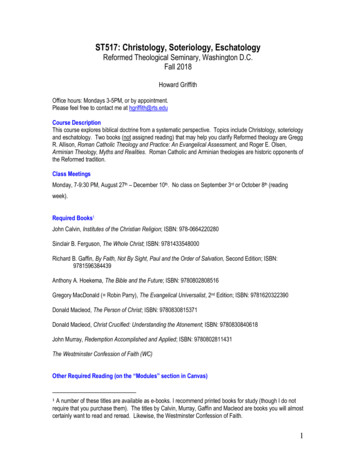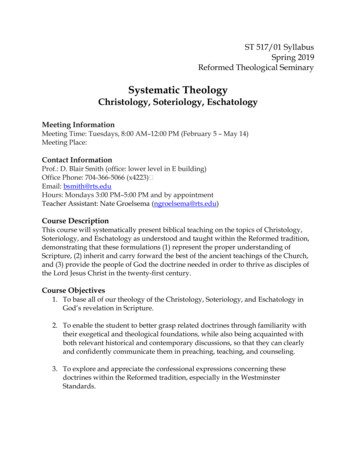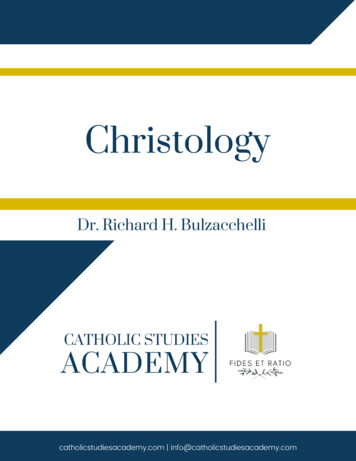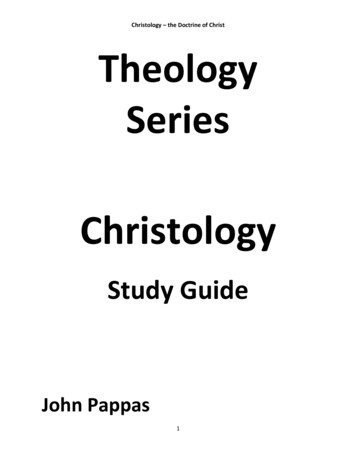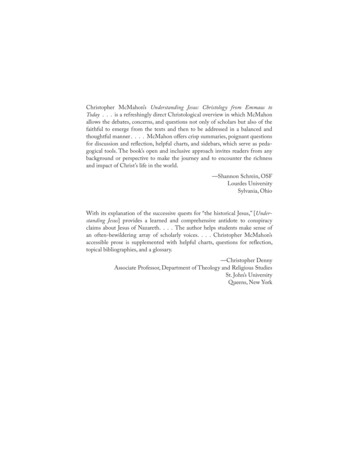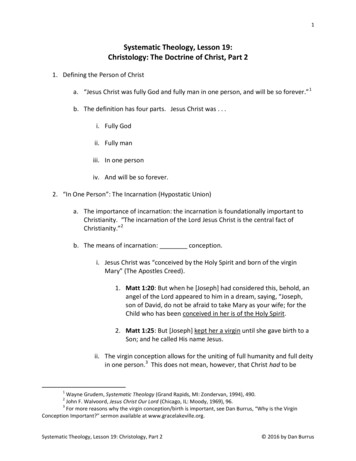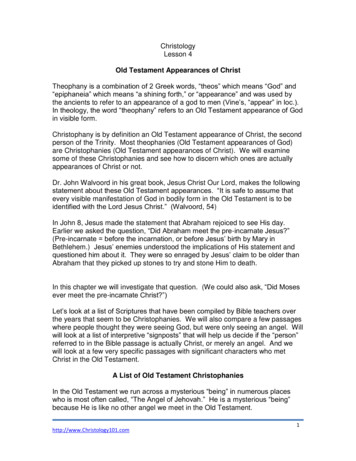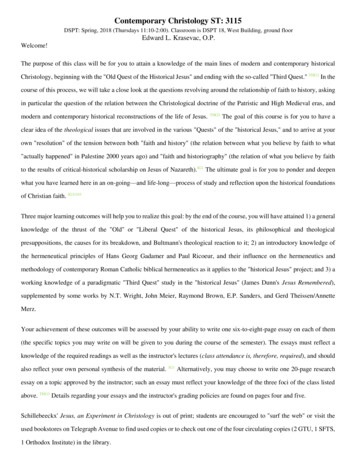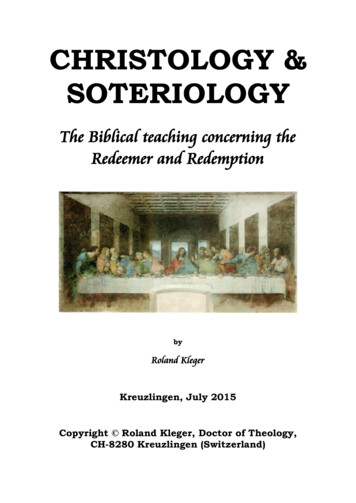
Transcription
CHRISTOLOGY &SOTERIOLOGYThe Biblical teaching concerning theRedeemer and RedemptionbyRoland KlegerKreuzlingen, July 2015Copyright Roland Kleger, Doctor of Theology,CH-8280 Kreuzlingen (Switzerland)
Christology.Soteriology.engl.7.2015 Roland KlegerI.1IntroductionChristology is the biblical teaching concerning Christ, the Saviour and Soteriology theteaching regarding salvation (redemption) and its personal appropriation.1510First of all we must ask ourselves why redemption is necessary. If there is a Redeemer, thenthere must also be someone who needs redemption. Biblical Anthropology teaches us thatmankind, since the fall of Adam and Eve, is completely depraved (corrupt, sinful; cf. Rom3:10.23; 5:12; Eph 2:1-3; Psa 51:7). Sin leads to death (Rom 6:23). God, in his love, does notwant man to be lost (cf. Eze 18:23), but rather that he repents (2Pe 3:9) and finds salvation(1Ti 2:3-4). The result of the fall of man is sin, death and judgement, and therefore the needfor redemption. The following sketch makes this clear:The fall of man and the way of salvation can be portrayed in the following way:15The will of Godman inrelationshipwith Godthe will of SatanThrough emancipation man separateshimself from God and so becomes aslave of Satan20The atoning death of Jesus Christ25THE CROSS30man delivered fromslavery through theblood of Christ3540The door that leadsback to Godman in the will/power of SatanFrom this we conclude: Since the fall, man is by nature separated from God, bound to Satanand spiritually dead: cf. Psa 51:7; Isa 59:2; Eph 2:1.3.In this brochure we will concentrate on the following three topics:1Christology: the Greek title Cristo.j means Christ, i.e. the Anointed One, and lo,goj (lógos) means in thiscontext teaching. Soteriology: the Greek title swth,r (sōtēr) means Saviour and the noun swthri,a (sōtēría)salvation. Hence, in Christology we speak about the Saviour and in Soteriology about salvation and itsappropriation.
Christology.Soteriology.engl.7.2015 Roland Kleger21. The person of the Redeemer2. The work and the threefold office of the Redeemer3. Redemption and its appropriation5Here are three key New Testament texts to introduce our study of Christology andSoteriology:10And we have seen and testify that the Father has sent his Son to be the Saviour of the world.(1Jo 4:14)Salvation is found in no one else, for there is no other name under heaven given to men bywhich we must be saved!(Act 4:12)15They replied, “Believe in the Lord Jesus, and you will be saved – you and your household!”(Act 16:31)
Christology.Soteriology.engl.7.2015 Roland Kleger3II. God’s plan of salvationA. God’s plan of salvation is realised in Jesus Christ51015Included in the word “salvation” is everything that God has done to save fallen mankind fromsin. This salvation or deliverance embraces all that God has done to achieve for mankind theplan of salvation which he prepared before the foundation of the world (Eph 1:4; 1Pe 1:20).The eternal and omniscient God knew in advance that man would sin. That however does notmean that God wanted it to be this way and that he is therefore responsible for it. No of coursenot, man misused his moral freedom just as Satan did before him along with the angels whofollowed him in his rebellion against God (cf. Rev 12:2-3; Isa 14:9ff; Eze 28:11ff; 2Pe 2:4and Jud 6). That does not change the fact that God is and will always remain sovereign overthe whole universe which he created through his Son Jesus Christ (cf. Joh 1:3ff; Col 1:15;Heb 1:2-3). God also knew in advance that he would send his Son into this world to savemankind from sin (cf. 1Pe 1:20) and who would accept his offer of grace in Jesus Christ (cf.Rom 8:29-39; Psa 139:14-16). God’s complete plan of salvation existed before the foundationof the world. if this were not so, then God would not really be God, or at least not theeternal, almighty and omniscient God of whom the Bible speaks.This full and complete salvation which through Jesus Christ must:20 25 be pleasing and acceptable to God, so that the fellowship between him and mankindcan be restored.be effective to blot out sin, because as a consequence of this man was separated fromGod.be effective in executing judgement over sin, because the Word of God must befulfilled (cf. Gen 2:16-17; Rom 6:23; Eze 18:4; Num 23:19).be effective in disarming Satan, the murderer and old liar (Joh 8:44), because he wasand is the originator of sin (cf. Joh 8:44; Heb 2:14-16; 1Jo 3:8).30Modern humanism assumes that man’s inner equilibrium is simply disturbed along with hisrelationship to his neighbours and surroundings. Therefore man seeks a way to save himself,e. g. through meditation or psychotherapy. That is the old attempt of man trying to savehimself, just as he did at the beginning of human history:35Gen 3:7Then the eyes of both of them were opened, and they realised that theywere naked; so they sewed fig leaves together and made coverings forthemselves.The Bible clearly rejects every attempt at self redemption:40
Christology.Soteriology.engl.7.2015 Roland Kleger4Jer 13:23Can the Ethiopian change his skin or the leopard its spots? Neither canyou do good who are accustomed to doing evil.Psa 49:7ffNo man can redeem the life of another or give to God a ransom for him– the ransom for a life is costly, no payment is ever enough – that heshould live on forever and not see decay!5There is only one way of salvation and that is the way offered to us in Jesus Christ (cf. Joh14:6; 1Jo 5:12-13; Act 4:12).10Rom 4:515However, to the man who does not work but trusts God who justifies thewicked, his faith is credited as righteousness.Man cannot save himself by any effort of his own even if all religions maintain this. It issolely the Biblical Christian faith that says that man is saved by grace alone. In the finalanalysis, Satan is the creator of all religions. He exploits the emptiness in the hearts of (sinful)men by offering each individual a religion that just suits him. Therefore everyone, rich orpoor, educated or uneducated, sophisticated or unsophisticated finds the religion that appealsto him. All religions are in fact a lie or and illusionary deception of Satan.20 for he is a liar and the father of lies.Joh 8:4425When considering redemption, we can and must only trust the revelation of God through hisword: Jesus Christ is the “Word” made flesh (Greek: lo,goj [lógos]; cf. Joh 1:1.14.18). If wewant to consider what salvation or redemption is, then we must first consider the Redeemerwho is the author of redemption (cf. Joh 4:22.42). The study of the person of Jesus Christ canbe divided into three chapters (parts): 301. Christ pre-existentoPräexistenz Christi2. Christ incarnate3. Christ exaltedWhat took place on the cross is in fact the central event in world and salvation history. Wecan thus understand why God gave Adam the promise of salvation before he punished him.35Gen 3:154045And I will put enmity between you and the woman, and between youroffspring and hers; he will crush your head, and you will strike his heel.God’s promise here is called the “Proto-Gospel”. It can be compared with a bud which growsand finally becomes a wonderful flower or fruit. “The seed” or “the descendant” of thewoman signifies a descendant who will overcome the devil (the serpent). In the NewTestament, we see that Jesus Christ, the Son of God, fulfils this promise (cf. Gal 3:16.19; 4:46). This theme can be traced throughout the whole Old Testament. The coming of theredeeming offspring is announced in the Old Testament by means of symbolic types andprophesies. Here are some well known examples:
Christology.Soteriology.engl.7.2015 Roland Kleger 5 10 15 20 25 30 355Gen 49:10:“The sceptre will not depart from Judah, nor the ruler’s stafffrom between his feet, until he (hl{yvi [Šīloh] owner) comes to whom it belongs and theobedience of the nations is his.”Exo 12:the Passover lamb (cf. Joh 1:29; 1Co 5:7-8)Leviticus:The high priest (cf. Heb 4:14-16; 8:1ff)Num 24:17-19:“I see him, but not now, I behold him, but not near. A star willcome out of Jacob; a sceptre will rise out of Israel. He will crush the foreheads ofMoab, the skulls of all the sons of Sheth.” (cf. Rev 22:16)Deu 18:15ff:“The Lord your God will raise up for you a prophet like mefrom among your own brothers. You must listen to him.” (cf. Joh 4:25-26; Act 3:21ff)2Sa 7:12-13.27: “When your days are over and you rest with your fathers, I will raiseup your offspring to succeed you, who will come from your own body and I willestablish his kingdom. He is the one who will build a house for my Name, and I willestablish his throne forever.” (cf. Isa 11:1.10; Jer 33:15; Mat 22:42-44; Luk 1:32-33;Act 2:29ff; Rom 1:3-4; Rev 5:5)Psa 22; 69 etc:Many psalms are called “Messianic psalms” because theyincorporate prophesies concerning Christ (cf. e.g. Psa 22:2 with Mat 27:46; Psa 22:9with Mat 27:43; Psa 22:19 with Mat 27:35 and Joh 19:24; Psa 69:10-11.24-25 withJoh 2:17; Rom 15:3; 11:9-10 and Act 1:20).Isa 7:14:“Therefore the Lord himself will give you a sign: the virgin willbe with child and will give birth to a son and will call him Immanuel.” (Mat 1:23)Isa 53:The servant, who bears the sin of the people: Mar 15:28; Luk 22:37;Joh 12:38; 1Pe 2:22-24.Dan 7:13:“In my vision at night I looked, and there before me was onelike a son of man, coming with the clouds of heaven. He approached the Ancient ofDays and was led into his presence.” (cf. Mat 24:30; Rev 1:7)Mic 5:1-2:“But you, Bethlehem Ephrathah, though you are small amongthe clans of Judah, out of you will come for me one who will be ruler over Israel,whose origins are from of old, from ancient times.” (cf. Mat 2:6)Zec 9:9; 12:10:“Rejoice greatly, oh daughter of Zion! Shout, Daughter ofJerusalem! See your King comes to you, righteous and having salvation, gentle andriding on a donkey, on a colt, the foal of a donkey. . . . They will look on me, the onethey have pierced, and they will mourn for him as one mourns for an only child, andgrieve bitterly for him as one grieves for a first born son.” (cf. Mat 21:5; Joh 19:37;Rev 1:7)This is probably the way in which Jesus, following his resurrection, explained that allScripture (at that time the Old Testament) testified to him. (cf. Luk 24:27.44-46).40“But when the time had fully come”, the Son of God came into the world:Gal 4:445But when the time had fully come, God sent his Son, born of a woman,born under law The expression “the time had fully come” simply means “end of time”:1Pe 1:20 He was chosen before the creation of the world, but was revealed inthese last times for your sake.
Christology.Soteriology.engl.7.2015 Roland KlegerHeb 1:256 in the last days he has spoken to us by his Son, whom he appointedheir of all things, and through whom he made the universe The following question arises. Why did Christ appear at the time he did and not earlier, e.g.directly following the fall of man?B. The unfolding of God’s plan of Salvation101520253035God created man in his own image, male and female he created them (Gen 1:26-27). Manbears the “image of God”, implying a special relationship between him and his Creator. Manis made for fellowship with his God, his Creator. This is seen in Gen 2–3: Yahweh conversedwith man. Because man is made in the image of God, he is a moral (ethical) being. There is arelationship of love between the Creator and his creation. Love is contingent upon freedom aswell as responsibility. The boundaries of the freedom and responsibility are contained in thecommand which Yahweh gave to man in the Garden of Eden following his creation: “And theLord God commanded the man: ‘You are free to eat from any tree in the garden; but you mustnot eat from the tree of the knowledge of good and evil, for when you eat of it you will surelydie.’” (Gen 2:16-17). Without freedom of choice, there is neither love nor true fellowship; lifewould be reduced to the existence of a robot or puppet! Unfortunately man let himself bedeceived by the serpent (Satan); he wanted to “be like God”, a status which God had notplanned for him (cf. Gen 3:5-7). Satan managed to draw man into the very same sin that hehimself had committed (cf. Isa 24:11-14; Eze 28:13-17; 2Pe 2:4; Jud 6). At the end of time,man’s rebellion against God will culminate in the same sin: the Antichrist will proclaimhimself to be God and demand the worship of all mankind (cf. 2Th 2:4 and Rev 13:14ff).2God is holy and there is no darkness in him (cf. Isa 6:3; Jam 1:17; 1Jo 1:5). His holiness alsodemands the holiness of his creation, man, created in his image (cf. Lev 19:1; 1Pe 1:16). Sincannot exist in the presence of God. This is also the reason why sin brought with it separationfrom God (cf. Isa 6:5; 59:2). This became clear at the moment when Adam and Eve wanted tohide themselves from Yahweh in the Garden of Eden. After their punishment waspronounced, they were driven out of the garden of Paradise, away from the presence ofYahweh (cf. Gen 3:22-243). As already mentioned, if God had wanted to, he could have slainAdam and Eve directly after the fall – he could for example have got rid of the whole universeand created a new one. But he did not do this. Why not? Because God loves man and createdhim in his own image; he had a plan of salvation ready for him. His Son was to come into theworld, become man, and take upon himself the punishment of man i.e. his sin (cf. Isa 53; 1Co1:30; 2Co 5:21; Heb 4:14-16; 9:24-26). In this way, the fellowship between God and manwould be restored (Rom 5:1-2; Col 1:19-20; Heb 10:19-22). But God the Father did notchoose to send his Son into the world directly following the fall of man. Rather he promisedto send the Saviour who would vanquish Satan (Gen 3:15; 1Jo 3:8). Until the fulfilment ofthis promise, man should realise the tragedy of his sin and discover his inability to freehimself from his lost state through his own strength or devices.40We do not know what instructions or what means of absolution God gave to Adam and Eveso that they could obtain forgiveness of their sins. We can only put forward suggestions. To2More on this subject is found in the chapter on the fall of man in my brochure “Biblical Anthropology”.Compare with Rev 22:1-5: In the new creation the glorified believers will re-discover Paradise, which was in away lost through the fall of the first people. On that day, the children of God will finally not only see the Sonface to face but also the Father. (cf. Joh 1:18; Exo 33:20; 1Ti 1:17; 6:16; 1Jo 4:12.20).3
Christology.Soteriology.engl.7.2015 Roland Kleger510152025303540use the word “speculation” here would have pejorative overtones. May be we could speak of“reading between the lines”. In Gen 3:21, it says that after Adam and Eve had sinned and Godhad pronounced judgement on them, he made them garments of skin and clothed them. Moreinformation cannot be found in the context. In the light of the whole of Scripture however, wecould possibly deduce certain things. It is no use seeking more information on the subject inthis passage. However, in the light of the whole body of Scripture certain deductions can bemade. In order for someone to be clothed in animal skins, an animal must first die. It is truethat nothing is impossible with God and he could have created an animal skin out of nothing(ex nihilo). But we may deduce from Gen 4 (which speaks of Adam and Eve’s son Abelsacrificing from the firstborn of his flock) that Yahweh had already given the first of mankind(directly following the ‘fall’) directions to seek forgiveness of sin through the sacrifice of ananimal. Heb 9:22 tells us that without the shedding of blood there is no forgiveness, becausethe life is in the blood (Lev 17:11). However, it was man who sinned and consequently hewas really the one who should have died. For the consequence (wages) of sin is death (Gen2:16-17; Rom 6:23), and the soul who sins is the one who will die (Eze 18:20). The letter tothe Hebrews teaches us that the blood of bulls and goats cannot really take away sin (Heb10:4). The blood of animals has, since the fall of man, only had a symbolic or typologicalmeaning. It pointed to (or was a picture of) the perfect blood of the incarnate Son of God. Butthe man who (since the time of Adam) sacrificed, testified (1) to his need of forgiveness and(2) to his dependence on someone who would pay the price of redemption (propitiation) forhim (cf. Mar 10:45; Heb 2:9-11). Scripture shows that the sins committed by believers underthe old covenant were provisionally covered by the sacrifices offered according to Mosaic lawthrough the longsuffering of God and in anticipation of the final and eternal sacrifice of JesusChrist through which sins would be blotted out once and for all (cf. Heb 9:15). The Christianfaith is logical: The person who sins must die. Consequently, Adam and with him all hisdescendents who have inherited his sinful nature must die. Since all have sinned (Psa 51:7;Rom 3:10.21-23), no one can get out of this predicament in his own strength. Only God could(and can) provide a way out. And this could not be just any old solution. God had warned manthat if he disobeyed, he would die. Since God cannot lie (Num 23:19), man had to bepunished for his sin. Is there a way out of this dramatic situation? There is only one and that isthat God, who is without sin, should himself pay man’s debt. This solution was only possiblein that God became a man in order to die in the place of sinful man. The eternal andomniscient God had made provision for this from eternity. We could object to this by sayingthat if God were to become a man and die, he would cease to exist. Otherwise he would nothave died! This is in fact a further proof for the plurality of the Godhead. It is also animportant argument for the teaching of the trinity! God the Father sent his Son to die onbehalf of mankind (Joh 3:16). The Son obeyed the Father and sacrificed himself through theeternal Spirit (Heb 9:15); on the third day, the Father raised him from the dead by the sameSpirit (Rom 8:9-11; cf. 1Pe 3:18). This plan of salvation, especially the incarnation of JesusChrist the Son of God, is a mystery (cf. 1Ti 3:16) into which angels desire to look. The OldTestament prophets sought to search out and understand the time and circumstances to whichthe Spirit of Christ in them was pointing:1Pe 1:10-1245507Concerning this salvation, the prophets, who spoke of the grace thatwas to come to you, searched intently and with the greatest care, tryingto find out the time and circumstances to which the Spirit of Christ inthem was pointing when he predicted the sufferings of Christ and theglories that would follow. It was revealed to them that they were notserving themselves but you, when they spoke of the things that have nowbeen announced to you by those who have preached the gospel to you
Christology.Soteriology.engl.7.2015 Roland Kleger8by the Holy Spirit sent from heaven. Even angels long to look into thesethings.5Christ is the ultimate Word of God (cf. Heb 1:2). There is no sacrifice for redemptionfollowing his. Christ is the end of the law (Rom 10:4), and through his sacrifice the believer ismade perfect once and for all:Heb 10:10.141015And by that will we have been made holy through the sacrifice of thebody of Jesus Christ once for all. . . . Because by one sacrifice he hasmade perfect forever those who are being sanctified.The example of old, pious Simeon (cf. Luk 2:25-35) shows clearly that there had always beenpeople who feared God and who had believed the promise of the coming of the Redeemer.The Holy Spirit had revealed to Simeon that he would not die before he had seen “the Lord’sChrist” (v. 26: to.n cristo.n kuri,ou [ton christon kuríou]). Since the very beginning, therehave always been people who believed in the coming of the Redeemer. Chapter 11 of theletter to the Hebrews gives us a list of men and women of God, who believed that God wouldfulfil his promises and who were waiting for the future (heavenly) city. Verse 13 of thischapter summarises this pertinently:20Heb 11:13All these people were still living by faith when they died. They did notreceive the things promised; they only saw them and welcomed themfrom a distance. And they admitted that they were aliens and strangerson earth.25303540The message of salvation is unfolded through the whole of Scripture, beginning with thepromise of the coming Redeemer (Gen 3:15 – the so called proto-gospel) until its fulfilmentwith the incarnation into this world of the Son of God. The whole Bible revolves on thispivotal event in world history. I will attempt to trace God’s plan of salvation by summing upthe most important events and examples (types) chronologically which led to itscompletion in the coming of Christ and his saving work:Directly following the fall (Gen 3), we read that Abel, the son of Adam and Eve, feared Godand brought him a pleasing sacrifice (Gen 4). Abel is the first to be mentioned in the long listof the heroes of faith in Heb 11 (see v. 4). Abel’s sacrifice points to the coming final sacrificeof Christ. Sadly mankind moved further and further from God until God finally – in the timeof Noah – pronounced judgement. Noah and his family were the only ones who feared God(Gen 6–9; cf. Mat 24:37ff; 2Pe 2:5). After the flood, Noah offered sacrifices showing his trustin God (Gen 8:20-21). Shortly after the time of Noah, mankind distanced itself from Godagain, only too quickly. This time, following their building of the tower of Babel and resistinghis command to people the earth, God judged them by confusing their language (Gen 11).45Unfortunately mankind once again had not learned its lesson and had turned from God. Thistime was a turning point in salvation history: God called one man, Abram, to be the father ofall who, like him, would put their trust in the one true God and not in heathen gods or idols.At this time, the worship of idols was practiced everywhere, even in Ur, where God hadcalled Abraham (cf. Gen 11:27ff; 15:7; Jos 24:2-3).50God had promised Abram that he would make of him a great nation (Gen 12:1ff). Abram andhis people should be a testimony to all nations. God promised him a country, Canaan, whichwould later be called Israel, after the new name of Jacob Abraham’s grandchild (cf. Gen
Christology.Soteriology.engl.7.2015 Roland Kleger5101532:28). Where ever Abraham went, he gave expression to his faith in God by offering himsacrifices. His faith in God culminated in his willingness to sacrifice Isaac the son of promise(Gen 22). This sacrifice prefigured in many ways the eternal sacrifice of Jesus Christ:Abraham was ready to sacrifice Isaac, the son of promise on mount Moriah (hY"rIAm [Mōrīyyāh]).Moriah was the place where Solomon later built the temple of Jerusalem (cf. 2Ch 3:1). In thesame way, God the Father gave his only Son (Joh 3:16; 1Jo 4:9-10) as a sacrifice in Jerusalem(cf. Luk 13:33). This shows that even in the first book of the Bible, Genesis, there was amovement towards Jerusalem! But first of all Abraham’s descendents had to go through aspecial (typological) experience which would point to final salvation through Jesus Christ:God announced to Abraham that his descendants would pass four hundred years as slaves inanother country, that he would free them and give them the promised land which wouldstretch from the river of Egypt to the Euphrates (Gen 15:13-21). Israel’s slavery in Egypt anddeliverance are types of the redemption of believers from the slavery of sin and their eternallife in Jesus Christ. This typology is of course emphasised by the fact that Mary and Josephhad to flee to Egypt after the birth of Jesus because of the fear that Herod would kill theirchild (cf. Mat 2:13ff). The exodus of Israel from Egypt prefigures the return of Jesus to Israelwith his parents:Mat 2:1520253035.where he stayed until the death of Herod. And so was fulfilled whatthe Lord had said through the prophet: “Out of Egypt have I called mySon” (cf. Hos 11:1)It was the Angel of the Lord who led Israel out of Egypt (cf. Exo 3:2ff). We will see in thenext chapter (The Pre-existence of Jesus Christ) that the Angel of the Lord is identical withthe Son of God before his incarnation. The apostle Paul confirms in 1Co 10:1-4 (“and thatrock was Christ”) that Christ led Israel out of Egypt and guided them in the desert. After theexodus from Egypt, God led his people in the desert of Sinai and gave them his law (theMosaic Law) through Moses. So Moses became the mediator of the Old Covenant andtherefore a precursor of Christ, the mediator of the New Covenant (cf. Gal 3:19ff; Heb 7:22;8:1-11; 9:15; 12:24; 2Co 3:6; Mat 26:28). God had already announced through Moses that hewould send a prophet like him (i.e. like Moses) and that all who would not listen to himwould be judged (cf. Deu 18:15-18). The apostle Peter confirms that this prophecy wasfulfilled in the coming of Jesus Christ (cf. Act 3:22-26). It is mainly the apostle Paul whoexplains the purpose of the Mosaic Law: It shows man his sinfulness and inability to keep thedemands of the law (cf. Rom 3:19-20; 7:7; Jam 2:10). It was put in place to lead us(pedagogue) to Christ:Gal 3:19.24-2540459What, then, was the purpose of the law? It was added because oftransgressions until the Seed to whom the promise referred had come.The law was put into effect through angels by a mediator. . . . So thelaw was put in charge to lead us to Christ that we might be justified byfaith. Now that faith has come, we are no longer under the supervisionof the law.God gave Moses instructions for building the tabernacle (see Exo 25–40). The tabernaclewould serve as a sanctuary for God among his people:Exo 25:8Then I will have them make a sanctuary for me, and I will dwell amongthem.50In this tabernacle, Moses spoke with the Lord face to face:
Christology.Soteriology.engl.7.2015 Roland KlegerExo 33:7-11510152025303540455010Now Moses used to take a tent and pitch it outside the camp somedistance away calling it the “tent of meeting”. Anyone inquiring of theLord would go to the tent of meeting outside the camp. . . . The Lordwould speak to Moses face to face as a man speaks with his friend.Then Moses would return to the camp, but his young assistant Joshuason of Nun did not leave the tent.The Lord who spoke with Moses face to face was without doubt Christ, the Son of God. Noone can see the Father except the Son (cf. Joh 1:18; 1Ti 6:16; probably also Exo 33:20). As Isaid before, in the new creation, the glorified believers will at last see the Father face to face(Rev 22:4). The tabernacle represented God dwelling among men. The sacrifices which werebrought (see Leviticus) prefigured Christ, the perfect high priest and his work of salvation.The main purpose of the letter to the Hebrews is to demonstrate the superiority of the personof Jesus over the angels (ch. 1 and 2), Moses (ch. 3), Joshua (ch. 4) and Aaron (ch. 5 and 7),also the superiority of the work and ministry of Christ over that of Moses and Aaron (ch. 8 to10:18). The introduction of the feast of the Passover in Exo 12 justifies particularly atypological interpretation of many events and rituals in the Pentateuch. A lamb withoutblemish had to be slaughtered and its shed blood would protect all those from the angel ofdeath who obeyed God’s instructions and put some on the sides and tops of the doorposts oftheir houses. This helps us to understand why Jesus in the New Testament is called “the Lambof God” who takes away the sin of the world (cf. Joh 1:29; Rev 5:6.12) and “our Passoverlamb” (1Co 5:7). As far as the tabernacle and the temple are concerned, Jesus, the incarnateSon of God, spoke of his body as a temple (cf. Joh 2:19-22). This is also the reason why Jesussaid the kingdom of heaven was near (Mat 4:17) yes even (already) among them hiscontemporaries (cf. Luk 17:21; Mat 12:28). How are we to understand this? Very simply, thekingdom of God is where Jesus is. Because the Jews rejected their Messiah, their King, thekingdom of God was taken away from them and given to another people (Mat 21:43).“Another people” refers to all those out of the nations who have received Jesus as their Lordand Saviour and who thus inherit the kingdom (cf. 1Pe 2:9; Rev 2:26-28; 5:10; 20:4-6).However, this kingdom is obviously not yet manifest. The question of the disciples to therisen Lord in Act 1:6 must be understood in this way. At the ascension of Jesus, the kingdomof God (in the fullest sense) went so to say with him. It will only (in its entire fullness) beestablished on earth when Christ returns (cf. Luk 19:11-12; 1Co 15:23-28; 2Ti 4:1).According to the apostle Paul, a Christian who believes he reigns in this life already is livingunder an illusion (cf. 1Co 4:8-13).Let us return though to the tabernacle and temple. After the death of Jesus, the curtain whichseparated the most holy place from the sanctuary was torn in two (Mat 27:51). This was avisible sign that henceforth every true believer would have access to the most holy place (cf.Heb 10:19ff) and that it would no longer be necessary for the high priest to bring blood intothe most holy place once a year (on the day of atonement, Yom Kippur: cf. Lev 16:2.34; Heb9:7). When Christ returns, he will rule over the whole world in Jerusalem (cf. Dan 2:35; Zec14:8-9.16-17; Isa 24:23). He himself will be both King and High Priest. This is probably thereason why there is no mention of a high priest in connection with the temple during thekingdom spoken of in Eze 40–48. Only in eternity, when glorified believers live in thepresence of the Father and the Son, will there be no more temple because then the Father andthe Son will themselves be the temple (cf. Rev 21:22).Once the people of Israel were settled in the promised-land, the tabernacle was substituted bythe temple. Moses had warned the people of Israel that if they were unfaithful, God would
Christology.Soteriology.engl
Christology is the biblical teaching concerning Christ, the Saviour and Soteriology the teaching regarding salvation (redemption) and its personal appropriation. 1 5 First
